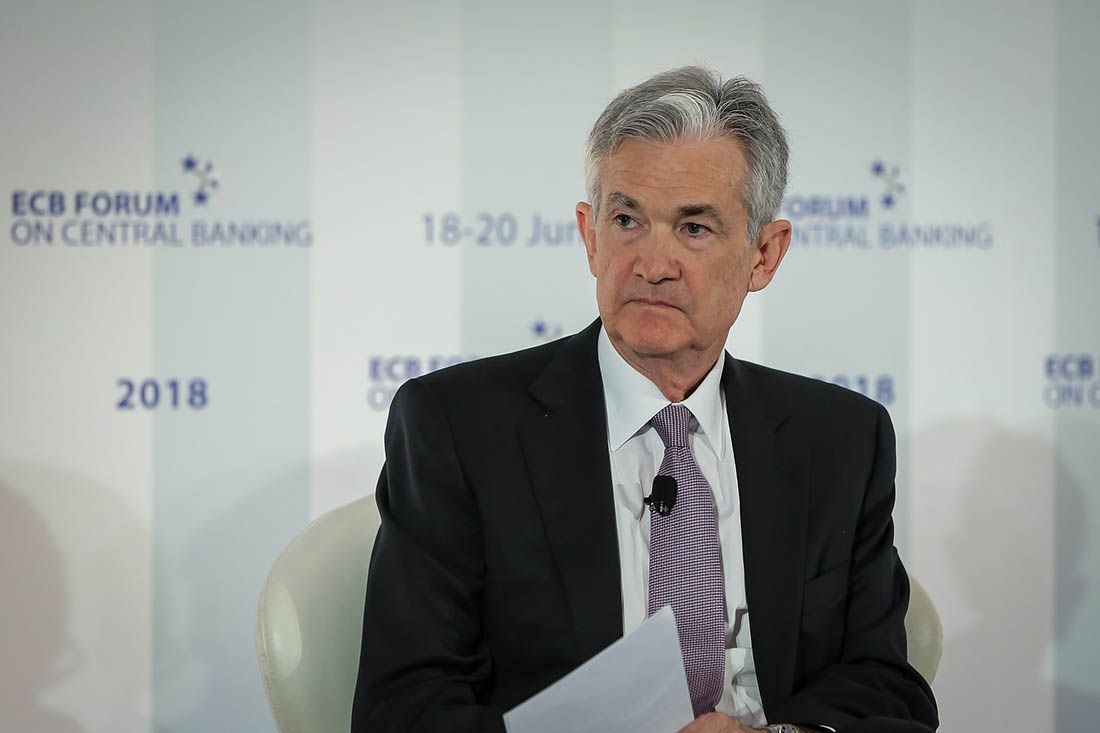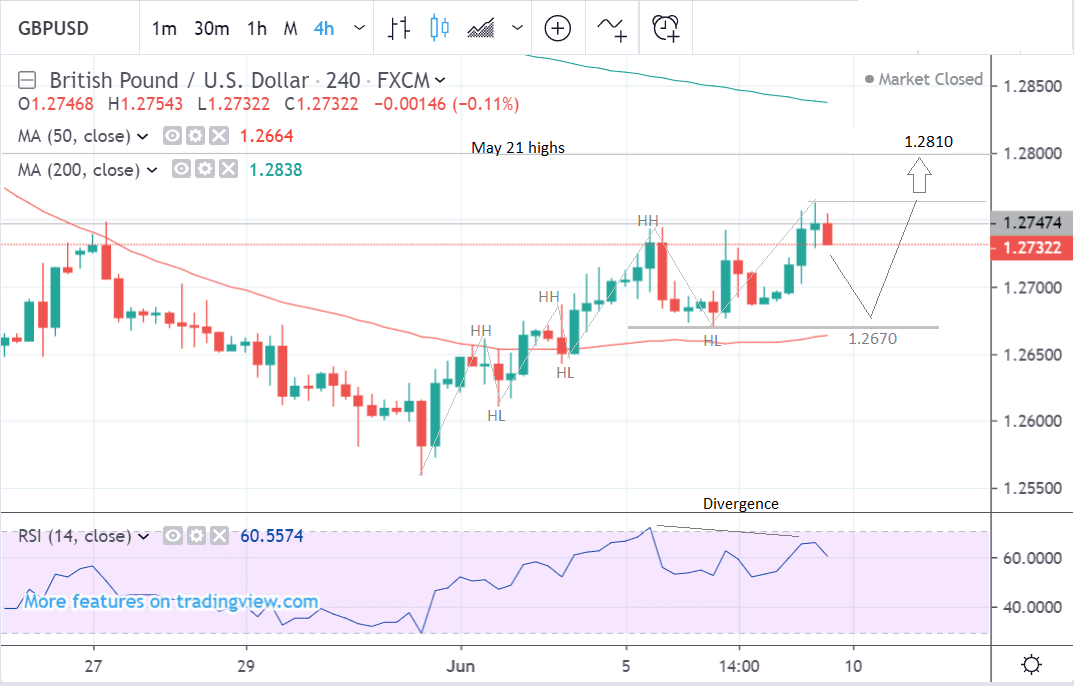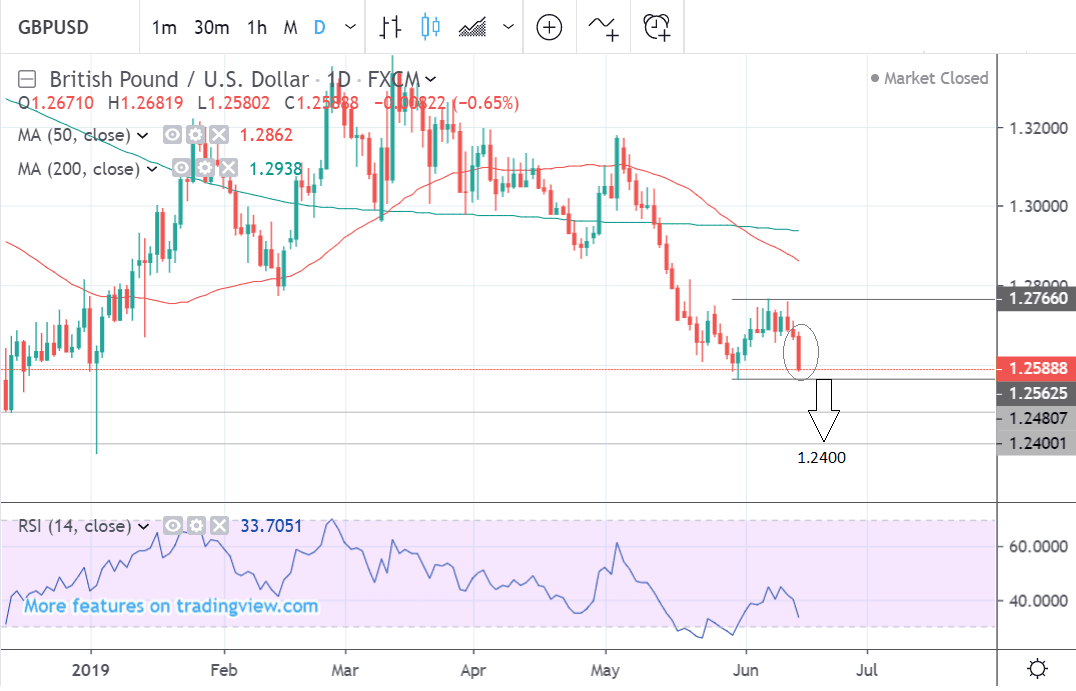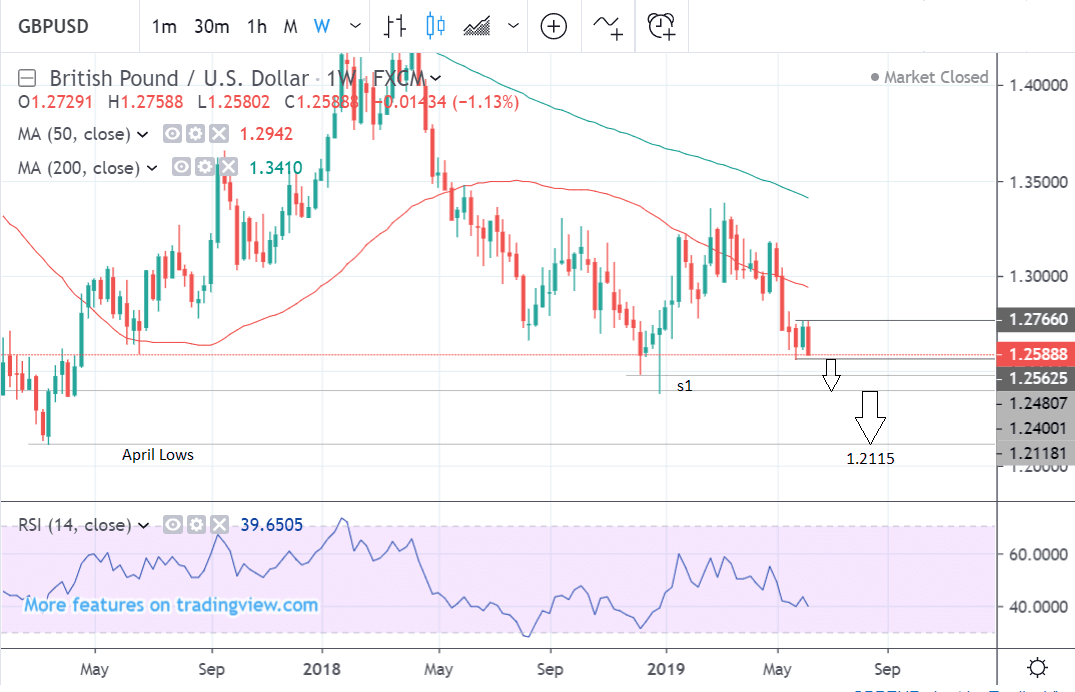Pound Sterling vs. Dollar 5-Day Forecast: Charts Hint at Weakness but UK Politics and FOMC Could Spring a Surprise

The Federal Reserve's Jerome Powell steals the market limelight in mid-week trade. Image © European Central Bank
- GBP/USD to move sideways or decline in short-term
- Break below May lows would be key for extension of downtrend
- Boris Johnson now 'in the price' of Sterling, could prompt GBP gains
- Dollar eyes key Fed meeting
The Pound-to-Dollar rate is trading at around 1.2589 at the start of the new week, after falling 1.13% in the previous week. Studies of the charts suggest that the exchange rate is likely to continue falling over the next five days but we are wary of a bounce in Sterling on domestic politics and the midweek U.S. Federal Reserve meeting.
Looking at the technicals in more detail, the 4-hour chart shows the pair has declined steeply, almost all the way down to the May lows at 1.2559. It will probably continue down to those lows but afterward will probably bounce.
The RSI momentum indicator is now in the oversold zone under 30 and this indicates an increased likelihood of a bounce or period of sideways market activity.
We see the pair probably oscillating between the May lows and the June 10 highs at 1.2653 over the short-term, defined as a period of about a week, and for which we use the 4 hr time frame charts.
Given the overarching trend is bearish, however, we expect the pair to eventually break lower.
If it pierces below the May lows and especially if it closes below them on a 4 hour basis, it will probably continue down to a target at 1.2500.
The daily chart is looking much more bearish after having formed a long, red, down candlestick on the last day of last week (circled).
Similarly, a break below the May lows at 1.2559 - especially on a closing daily basis - would probably result in a continuation lower to a target at 1.2400.
This is where the s1 monthly pivot it situated, a level used by traders to gauge the strength of the trend. Pivots are also levels of support and resistance in themselves. It is a medium-strength support level which is likely to provide a short-term floor for prices.
We use the daily chart to give us an indication of the medium-term outlook which includes the next week to a month ahead.
The weekly chart shows a long-term bearish trend unfolding.
This is likely to continue subject to a break below, or better a close on a weekly basis below the 1.2400 pivot level.
Such a move would lead to a continuation down to a target at the April 2017 lows of 1.2115.
We use the weekly chart to give us an idea of the longer-term outlook, which includes the next few months.
Time to move your money? Get 3-5% more currency than your bank would offer by using the services of foreign exchange specialists at RationalFX. A specialist broker can deliver you an exchange rate closer to the real market rate, thereby saving you substantial quantities of currency. Find out more here.
* Advertisement
The Dollar: What to Watch

The most important event for the U.S. Dollar is the meeting of at the U.S. Federal Reserve's FOMC to decide monetary policy and set interest rates, on Wednesday at 14.00 BST.
The Fed is not expected to cut interest rates but there is an outside chance it may do because of subdued inflation and a negative outlook for the economy.
There is a higher chance it could hint at a possible cut in the near future, either in the statement or via Chairman Powell’s press conference.
The ‘dot-plot’ diagram of Fed member’s future interest rate expectations is also likely to change and reflect a growing dovishness - which means in favour of lower interest rates.
An actual cut or hint of one would weaken the U.S. Dollar by reducing the attractiveness of the country as a destination for foreign capital inflows.
“The Fed will be the first of the three central banks to make its policy announcement next week and is expected to keep the fed funds rate unchanged at the target range of 2.25-2.50%,” says Raffi Boyadijian, an economist at FX broker XM.com. “But with markets convinced that a rate cut at the following meeting in July is a foregone conclusion, traders could be disappointed if the Fed falls short of giving outright signals of lower borrowing costs.”
Such a disappointment would likely trigger Dollar strength.
There is also the possibility the Fed may make a ‘pre-emptive’ cut to interest rates from its current relative position of strength - just in case market fears of a slowdown are warranted.
This surprise would likely send the Dollar lower.
“Regardless of what cards remain to be dealt, the Fed is holding a pretty strong hand. The preponderance of employment data suggests the Fed is meeting its mandate of achieving maximum employment, while inflation is running below expectations. The Fed has room to ease pre-emptively to head off a more substantial pullback in domestic demand and untoward deceleration in inflation,” say economists at Wells Fargo.
Other data is less likely to be of concern as the FOMC will dominate the calendar, nevertheless, building permits and housing starts are forecast to rise marginally in May when the data is published at 13.30 on Tuesday, June 18.
Another major release is the PMI activity indicator for June, out on Friday, June 21, at 14.45.
PMIs are widely seen as a leading indicator for the economy and growth. A lower-than-expected result would weigh on the Dollar and vice-versa for a higher.
Manufacturing PMI is forecast to remain at 50.5 when it is released and services PMI is expected to show a rise to 51.0 from 50.9 in the previous month.
The Pound: Boris 'in the Price'

Brexit politics is still likely to have the greatest impact on Sterling, with the Bank of England (BOE) rate meeting, CPI and retail sales data also likely factors driving the exchange rate.
The race to become the next Conservative leader and Prime Minister will continue next week with the vote to decide who goes through to the next round late on Tuesday, June 18. This time the seven remaining contestants will need at least 32 votes to get through to the next round.
More rounds of voting are expected on Wednesday and Thursday at which MPs will finally whittle the contest down to just two remaining candidates.
These will then be put to a vote amongst the wider Conservative party membership.
The first round of voting amongst conservative MPs resulted in a clear win for Boris Johnson, who gained 114 votes - significantly more than his nearest rival Jeremy Hunt, who came second with 43. Michael Gove was third with 37.
It is widely expected that Boris Johnson will win the wider vote amongst Conservative members. It seems highly likely, therefore, he will be the next Prime Minister.
Markets are more-or-less accustomed to this outcome by now, and we therefore wonder if this outcome is already 'in the price' of Sterling: i.e. it is not a Johnson win that will move Sterling, instead we believe it is what he says about his intentions on Brexit that will most likely matter going forward.
We know Johnson favours a renegotiated deal with the EU, and a 'no deal' Brexit is not his preferred outcome on October 31.
However, if the EU are unwilling to renegotiate he has indicated that he will pursue a 'no deal' Brexit.
Therefore a Johnson win is not necessarily bad for Sterling, instead the key issue going forward will be how the EU reacts to his advances for a renegotiation, and his subsequent response.
As such, be wary of a potential recovery in Sterling over coming days as there is a chance market's pare back on their expectations for a 'no deal' Brexit.
"BoJo is likely the new PM in UK once the dust settles after all the balloting over the next few weeks. The thing that we look forward to the most, is when BoJo takes May’s deal to the commons again, just with a new name. We would by the way prefer to buy GBP, once Boris is confirmed as the PM – buy the rumour, sell the fact (in EUR/GBP)," says Andreas Steno Larsen, an analyst with Nordea Markets.
Bank of England Meeting Could Prove Supportive
Another key driver of the Pound is the Bank of England (BOE) policy meeting on Thursday, June 20 at 12.45 BST. Although it is not accompanied by a press conference the minutes published after the meeting may contain important information which could drive Sterling.
The BOE has adopted a hawkish stance of late - hawkish meaning in favour of higher interest rates - owing to the country's solid Labour market. Higher interest rates would be positive for Sterling as they attract higher net inflows of foreign capital.
“Despite the growth worries, however, and the rising risks of a no-deal Brexit, the BoE is sticking to its central projection that some tightening in monetary policy will be needed over the next 2-3 years,” says Raffi Boyadijian, an economist at XM.com. “With no press conference or quarterly forecasts scheduled for the June meeting, the BoE is widely anticipated to repeat the same message in its statement.”
There are two risks: 1) that the Bank strikes a more cautious tone due to slowing global growth, largely resulting from U.S.-China trade tensions. This could send Sterling lower. However, we note the UK is less exposed to global trade dynamics than other economies, such as the Eurozone. Therefore, this risk might not come to pass.
Or, 2) the Bank strikes a more optimistic tone owing to the ongoing strength of the labour market that continues to generate increasing wages. This in turn threatens higher rates of inflation in the future. If the Bank notes this, the Pound could find support, or go higher.
CPI and Retail Sales
As mentioned, inflation is a key concern for the Bank of England, and by extension Sterling. The outcome of Wednesday's inflation numbers could therefore be important.
UK inflation data is expected to show a slower 0.3% and 2.0% rise on a monthly and yearly basis in May, from 0.6% and 2.1% in April, when data is released on Wednesday at 9.30 BST.
A higher-than-expected result might impact mildly on the Pound as it increases the chances of the BOE raising interest rates.
Retail sales are forecast to show a -0.5% and 2.7% change on a monthly and yearly basis in May, compared to the previous 0.0% and 5.2% changes respectively, in April, as the economy continues cooling.
A lower-than-expected result might impact negatively on the Pound as it would suggest the slowdown was more acute. Lower sales suggest a slowdown in GDP since consumers are the main driver of the economy.
Time to move your money? Get 3-5% more currency than your bank would offer by using the services of foreign exchange specialists at RationalFX. A specialist broker can deliver you an exchange rate closer to the real market rate, thereby saving you substantial quantities of currency. Find out more here.
* Advertisement







